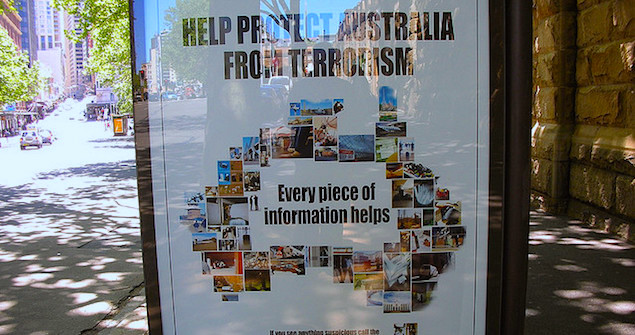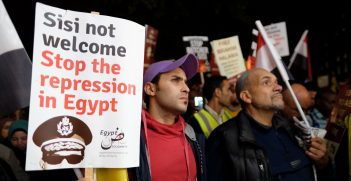G'Day Jihad: The Threat Posed by Australians in Syria and Iraq

In a week dominated by news about the attack against Charlie Hebdo by three suspected Islamist militants, it is argued that the threat posed by returning jihadists in Australia is a complex and concerning one.
2014 saw major developments relating to Australia’s traditionally minute jihadist community. This included the first fatal incident of jihadist terrorism on Australian soil, the largest counter-terrorism investigation in Australian history (Operation Appleby) and the introduction of various counter-terrorism laws through the Australian Parliament; laws which the Abbott Government declared necessary due to the threat posed by Australian foreign fighters if they return to our shores.
Having Australians fight in foreign conflicts is not a new phenomenon. Australians fought in both sides of the Spanish Civil War in the 1930s, volunteered in Israel’s War of Independence in 1948, and, more analogously, in Afghanistan during the Soviet occupation in the 1980s.
The key difference, however, is the documented threat posed by foreign fighters in theatres of jihadism upon their return home. Whereas George Orwell penned Homage to Catalonia after fighting fascism in Spain, men like Australia’s now infamous Khaleed Sharrouf will probably not return home, after beheading prisoners with the Islamic State of Iraq and al-Sham (ISIS), or gift the world with a novella like Animal Farm.
In arguably the most comprehensive study of returning Western foreign fighters to date, Thomas Hegghammer of the Norwegian Defence Research Establishment found that up to one-in-nine returning jihadist veterans returned to plot acts of domestic terrorism in the West. In what Hegghammer refers to as the “Veteran Effect”, such veterans were found to increase both the fatality and effectiveness of such attacks.
Around 46% of all plots in Hegghammer’s database (49 of 106) included at least one veteran, making them prominently represented. 29% of plots involving veterans were carried to completion, compared to only 18% of plots that did not involve veterans. 16% of attacks involving veterans caused fatalities, compared to only 7% of those that did not involve veterans.
In contrast to Hegghammer, the US-based Jytte Klausen has a far bleaker assessment of foreign fighters who go on to become domestic jihadists. As part of the Western Jihadism Research Project, Klausen, working with a data set of around 1500 Western foreign fighters, found that:
“There have been approximately 279 violent terrorist plots on Western soil since 1993 that were unrelated to the ongoing mobilisation in Syria and Iraq…of the 279 plots, 114 [41%] included foreign fighters. We identified 275 foreign fighters overall who participated in these plots. Taking a baseline number of nearly 900 foreign fighters (all pre-Syria)…approximately one-in-three Western fighters, or veterans of training camps, participated in a violent domestic plot.”
Currently, there are conflicting reports about the numbers of Australians fighting in Syria and Iraq. In June, Foreign Minister Julie Bishop said “150 Australians are or have been”. In December, Attorney-General George Brandis said that 20 Australians had been killed, with the corresponding ABC article citing 70 Australians fighting in the Middle East, with 20 having already returned home. More broadly, up to 11 000 fighters have joined the conflict in Syria, with around 3000 Westerners among them. Many have joined ISIS or Jabhat al-Nusra (al Qaeda’s regional franchise in Syria). This represents the largest mobilisation of foreign fighters since Afghanistan in the 1980s.
The elastic nature of these estimates aside, even if Syria turns out to have a relatively low ratio of returning veterans who go on to commit acts of terrorism (Hegghammer’s analysis involved many different conflicts, with some producing vastly greater numbers of domestic jihadists than others), the extremely high number foreign fighters means that the ratio of “blowback” from Western veterans will still pose a significant and complex national security threat.
The issue of blowback has begun to move from the realm of theory into the cold light of reality. Monash University’s Andrew Zammit has been compiling a list of alleged terrorism plots by returnees from Syria in the West, including the murder of four people in the Jewish Museum of Belgium in Brussels – an attack that will most likely go down as the first successful case of blowback on European soil.
The threat posed by returning jihadists from Syria and Iraq is an ongoing one, which will test the competency of the current (and successive) Australian government in the years to come. While not all foreign jihadists will return to become domestic jihadists, a significant number do. Precisely how many connected to Syria and Iraq will only become known in the future.
Joseph Power is editor of AIIA Queensland’s The Transnational Review and sits on AIIA Queensland Branch’s Executive Council.
This is a shortened and updated version of an article published in the AIIA’s Emerging Scholars 2014 publication.





